Doggy Limousine Service
Daniel Williams, Rapid Paws
 Daniel Williams quit his regular job to open a pet transport business, like Zoo-ber. He says it's going well although he has one customer than demands he talks to their dog only in 'baby-talk.'
Daniel Williams quit his regular job to open a pet transport business, like Zoo-ber. He says it's going well although he has one customer than demands he talks to their dog only in 'baby-talk.'
Daniel Williams, of Washington, D.C., is a co-owner and driver for Rapid Paws, a new limousine service for pets. It was started by Daniel and his partner, Paul Ozner, as a way to help people transport their pets in the Washington, DC area. They knew they wanted to start a business, and since they both have dogs and love pets, they wanted it to be pet related. They also knew there was a problem and a need for people who couldn't transport their pets to a vet appointment or even to a groomer. This might be because they work or they might not have access to a vehicle. There is also a big military presence that needed this type of service.
The weirdest request Daniel has received was when someone asked him if he talks baby talk to the animals. Daniel states it wasn't weird to him, as he talk baby talks to his own dog all of the time, but he could tell the man felt uncomfortable asking him. But when the question was asked, Daniel said the two of them really hit it off. So did he baby talk to this man's dog – of course!
 Daniel does a lot of promoting his business himself by going door to door and visiting the local dog parks and veterinarians offices. On one instance while Daniel was out, he bumped into a gentleman who worked for the Washington Post, resulting in the man then running an article on Rapid Paws.
Daniel does a lot of promoting his business himself by going door to door and visiting the local dog parks and veterinarians offices. On one instance while Daniel was out, he bumped into a gentleman who worked for the Washington Post, resulting in the man then running an article on Rapid Paws.
Rapid Paws just launched in April and are already receiving a great response from the public. They currently have two vehicles on the road and are hoping as business picks up they can add more vehicles and more employees.
http://www.rapidpaws.com
Fighting Fleas
Lucy Pet Foundation
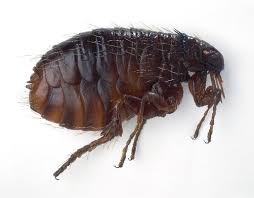 We're on the heels of another big flea season. Chances are good your pets will get fleas, unless you live in Las Vegas or Phoenix. Is there a safer solution than the traditional topicals? Doc Halligan says there are lots of safe remedies for the 'battle of the fleas.'
We're on the heels of another big flea season. Chances are good your pets will get fleas, unless you live in Las Vegas or Phoenix. Is there a safer solution than the traditional topicals? Doc Halligan says there are lots of safe remedies for the 'battle of the fleas.'
Doc Halligan claims that flea-related diseases comprise more than 50-percent of all skin cases in certain areas of the country. Fortunately, common household fleas are easily controlled with preventative measures, and today there are a lot of great products out there to help prevent, kill, and control fleas.
If you use a topical product on your pet, read the label and look at the active ingredients. Not all topicals are the same. Never use a topical product containing pyrethrin on cats, as it is toxic to them. However, you can use products containing fipronil, which is safe for cats and dogs. Because most topicals don't get into your pet's bloodstream, they can be safer then using oral medications. If you're not sure what product to use, ask your vet.
Does your pet have a bad reaction to fleabites? Doc Halligan states that this happens because some fleas have a certain protein in their saliva that when they bite your pet, they put it into your pet's skin. Some animals will then have an allergic reaction to this protein. This may cause some animals will break out over their entire bodies with sores from one bite, while other animals can be covered with fleas and not be bothered by them at all.
Because the length and severity of flea season varies across the country and changes from year to year depending on the temperature fluctuations and humidity, Doc Halligan recommends some form of flea control all year long. She states at the very least, you should start flea prevention in the spring to head off an infestation.
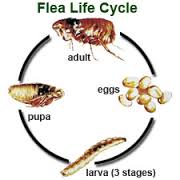 Learning more about fleas and their life cycle will help you understand why they become so prolific in such a short period of time and how to avoid an infestation. Although fleas thrive at 65 to 80 degrees F with humidity levels at approximately 80-percent, they have been known to survive indoors during the winter, even in cold climates. Fleas also travel - as much as one mile in an hour. They will hop inside through an open door or window and are often small enough to come through a window screen. Once inside your home, there's no place a flea can't go. Fleas can be miserable for you and your pet, and not just from the bites.
Learning more about fleas and their life cycle will help you understand why they become so prolific in such a short period of time and how to avoid an infestation. Although fleas thrive at 65 to 80 degrees F with humidity levels at approximately 80-percent, they have been known to survive indoors during the winter, even in cold climates. Fleas also travel - as much as one mile in an hour. They will hop inside through an open door or window and are often small enough to come through a window screen. Once inside your home, there's no place a flea can't go. Fleas can be miserable for you and your pet, and not just from the bites.
They can bring about a host of serious problems such as:
- Severe anemia: This condition is most commonly seen in very young or small pets with high numbers of fleas. Every year, kittens, puppies, and small dogs and cats suffer significant blood loss from fleabites that can actually lead to death from anemia. Signs include pale gums, weakness, and fatigue.
- Tapeworms: Cats and dogs develop tapeworms from ingesting a flea that is carrying the tapeworm larva.
- Flea Allergy Dermatitis: FAD is the most common allergic skin disease of dogs and cats. Animals that have flea allergy can develop a severe allergic reaction to a protein in the saliva of certain fleas that is left behind from fleabites. This condition causes severe itching, rash, and more. In dogs, it leads to hair loss and infection, usually on the rear legs or at the base of the tail; cats get scabs around the head, neck, and body. Medical treatment is needed.
- Plague: In rare cases, cats or dogs can get the bacteria that cause the plague from a rat flea or by ingesting a dead, infected animal. Symptoms include high fever, lethargy, and enlarged lymph nodes. Luckily, the disease is highly treatable if caught early.
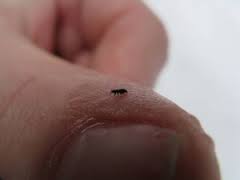 Flea facts:
Flea facts:
- Worldwide, there are more than 2,400 species of fleas.
- In the perfect environment, a flea can live for up to two years.
- The female cat flea consumes 15 times its own body weight in blood daily.
- A flea can jump 150 times its own length.
- Fleas have been around for 100 million years.
- Fleas can live without food for more than 100 days, but on average they live two to three months.
- Fleas can go through an entire life cycle, from egg to adult, in as little as 10 to 14 days.
- Unlike the mosquito, which eats once and goes off to digest its meal, fleas continue to repeatedly bite their hosts long after their hunger is satisfied.
- The most common flea on dogs and cats is the cat flea, Ctenocephalides felis.
- Cat fleas have been found infesting more than 50 different hosts throughout the world.
- In North America, a wide variety of non-domesticated hosts have been reported harboring cat fleas, including coyotes, red and gray foxes, bobcats, skunks, rodents, raccoons, opossums, and ferrets.
- Once on the host, the cat flea will initiate feeding within seconds and mating will occur on the host in the first eight to 24 hours, with most females having mated by 34 hours.
- Female cat fleas begin egg production within 36 to 48 hours of taking their first blood meal, reach maximum production between four and nine days, and are capable of producing eggs for over 100 days.
- Female fleas can lay 2,000 eggs in their lifetime, but the average is 1,348 eggs during their first 50 days on the host, equivalent to producing their body weight in eggs daily.
- The life cycle of the fleas involves an egg, larva, pupa, and adult, just like a butterfly.
- The pupa stage is the most difficult to kill, as it's very resistant to most chemicals and can stay in this state for up to one year waiting for the proper conditions to hatch.
- Cat fleas lay their eggs while on the host, your dog or cat, not in cracks and crevices. Flea eggs are not sticky and readily fall from the host and into their environment.
- Once flea eggs are in the environment, they will usually hatch in one to 10 days, depending on the temperature and humidity.
- Cat fleas spend their entire lives on your pet. They feed, sleep, and lay eggs, thousands of them, all on the back of your pet.
- For the cat flea, no life cycle stage (egg, larva, pupa, or adult) can survive for 10 days at 37.4 degrees F, or five days at 33.8 degrees F.
It's important to realize that only 5-percent of the total flea population is in the form of adult fleas on your pet. The other 95-percent is in various stages: 50-percent eggs, 35-percent larvae and 10-percent pupae that are not readily visible to the naked eye but are in your carpet, furniture, bedding, lawn and anywhere else your pet walks or lies down.
During feeding, female cat fleas excrete large quantities of incompletely digested blood known as "flea dirt," which dries within minutes into reddish-black pellets that look like pepper. If you place some of this flea dirt on a white paper towel and apply water, it will turn the towel red.
The key to controlling fleas is to interrupt their life cycle at an immature stage so they don't develop into adults. This means all pets in the household must be treated. When using preventative medication, always read all of the instructions prior to usage and never use on debilitated, very young, sick, or elderly animals without directions from your vet, and never use dog products on cats and vice versa.
The Mission of The Lucy Pet Foundation is to reduce pet overpopulation by having mobile spay/neuter clinics across the country and to support causes that benefit animal welfare. The Lucy Pet Foundation currently has two buses that travel around Southern California focusing on spaying and neutering. These buses are state of the art surgery units. Their next focus is in generating more funds to expand the work of these buses and have more across the country.
 The Lucy Pet Foundation not only offers free and reduced spays and neuters, they also do microchipping, vaccines and de-wormings. Spaying and neutering is not only great for pet population control, but it has been proven that an animal will live on an average of 40-percent longer after having this surgery.
The Lucy Pet Foundation not only offers free and reduced spays and neuters, they also do microchipping, vaccines and de-wormings. Spaying and neutering is not only great for pet population control, but it has been proven that an animal will live on an average of 40-percent longer after having this surgery.
Upcoming Clinics
Free Spay & Neuter for Los Angeles City Residents! Here is a list of upcoming free or reduced fee mobile spay and neuter clinics in California:
Call for more information, questions and to reserve space to get on the list: (855) 499-5829
May 14, 27, 30: Food 4 Less, 1748 West Jefferson Blvd., Los Angeles, CA Spay/Neuter APPOINTMENT ONLY; Vaccine Clinic 10:00am-2:00pm
May 16: Stetson Ranch Park, 13877 GlenOaks Blvd., Sylmar, CA Spay/Neuter APPOINTMENT ONLY; Vaccine Clinic 10:00am-2:00pm
May 17, 25: Superior Store, 133 West Avenue 45, Los Angeles, CA Spay/Neuter APPOINTMENT ONLY; Vaccine Clinic 10:00am-2:00pm
May 19: West Valley Shelter, 20655 Plummer Street, Chatsworth, CA Spay/Neuter APPOINTMENT ONLY; Vaccine Clinic 10:00am-2:00pm
May 20, 28, 31: Superior Store Pacoima, 9801 Laurel Canyon Blvd., Pacoima, CA Spay/Neuter APPOINTMENT ONLY; Vaccine Clinic 10:00am-2:00pm
May 24: Food 4 Less, 5100 N. Figueroa St., Los Angeles, CA Spay/Neuter APPOINTMENT ONLY; Vaccine Clinic 10:00am-2:00pm
County and City Vouchers accepted. But remember, you must get on a list to have your pet seen at these locations. Please call The Lucy Pet Foundation toll free at 1-855-499-5829 or Email: Info@lucypetfoundation.org to schedule an appointment, or register at the events.
See the current list of clinics at http://www.lucypetfoundation.org.
http://www.lucypetproducts.com
 Vegas Bats Positive for Rabies - What's the Risk? - Dr. Debbie
Vegas Bats Positive for Rabies - What's the Risk? - Dr. Debbie
Think your pet doesn't need a rabies vaccine because it lives indoors? Think again. Bats have been known to fly through open windows or chimneys. Dogs and cats that go outdoors are at risk for rabies exposure through wildlife. Felines that hunt and bring "presents" have added rabies risk.
Common questions about rabies:
What is Rabies?
Rabies is a viral disease causing encephalitis (brain inflammation) that affects all mammals including humans. The disease is almost always fatal. Over 55,000 people worldwide die of rabies every year, but fortunately U.S. human deaths are rare with 1 to 2 reported per year. Pet and farm animal rabies cases do occur in the U.S. though, usually after tangling with wildlife.
How is Rabies Passed?
Rabies is passed in saliva through the bite of a rabid animal. Less common exposures to rabies include aerosol transmission, mucous membrane contact or rare cases of organ transplant in humans.
What Are Symptoms of Rabies?
Excessive drooling, aggression, staggering and seizures are symptoms of rabies in animals. Wild carnivores, like coyotes, that avoid people are suspect if lacking fear and approaching humans. Nocturnal species like bats that are found out during daylight are also suspect for rabies.
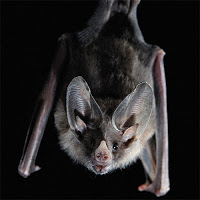 What Kind of Animals Carry Rabies?
What Kind of Animals Carry Rabies?
Although pet and human rabies cases in the U.S. are rare, the infection still abounds in wildlife reservoirs. In the Las Vegas area, bats are most commonly carriers, but other wildlife carriers include raccoons, skunks and foxes.
What Do You Do If You See a Sick or Dying Bat?
Avoid contact with sick or dying bats. Do not take sick bats to the veterinarian. Call Animal Control if any human or pet exposure to sick bat.
Despite the rabies concern, bats do have an important role in our ecosystem by consuming insects and pollinating plants. Not every bat has rabies, and there are other reasons bats die.
What Do I Do If a Person or Pet is Scratched or Bitten By a Bat or Other Wildlife?
If your pet gets into a fight with a skunk or raccoon, or plays with a dying or dead bat, there is potential for rabies exposure and a report should be made. Call animal control to have the bat or other wildlife picked up.
Possible rabies exposure is evaluated on a case-by-case basis. Because rabies is fatal, any humans with suspect rabies exposure should make a report to the local health department. Fortunately post exposure treatment for people is very effective in preventing disease, and doesn't involve painful stomach injections reported of long ago.
What Happens to Pets After Exposure to Suspected or Known Rabies?
Ultimately local rabies ordinances dictate how each case is handled. Pets with current or late rabies vaccinations may be quarantined for 10 days.
A pet that never has had a rabies vaccine may be promptly euthanized and tested for rabies. In other cases of unvaccinated pets, extended quarantine periods up to 6 months may arise.
What Can I Do to Protect My Pets and Family From Rabies?
- Vaccinate animals for rabies - this includes dogs, cats, ferrets and select farm animals.
- Teach children never to handle bats.
- Do not keep wild animals as pets.
- Spay and neuter your pets to decrease the desire to roam.
- Maintain control of your pets when outdoors or hiking to avoid accidental exposure to wildlife.
- Bat-proof your home and garage to avoid nesting sites and close encounters with bats.
- Report human bites from pets or wildlife to public health and animal control authorities.
Vaccination is key to protecting pets from rabies and offers peace of mind to pet owners. Rabies vaccine is typically inexpensive in the Las Vegas area. For example, a rabies vaccine at my hospital for dogs and cats costs just $10.00.
Rabies vaccination…Just do it!
Featured veterinarian known as "Dr. Debbie" on national pet radio program, Animal Radio. Ebook author of "Yorkshire Terriers: How to Be Your Dog's Best Friend"; "Pugs: How to Be Your Dog's Best Friend"; "Mini Schnauzers: How to Be Your Dog's Best Friend"; and "Shih Tzu: How to Be Your Dog's Best Friend."
http://www.drdebbie.net
5 Most Common And Uncommon Legal Pets
Robert Semrow, Animal Radio Listomania
 It's May and that means it's time for more national pet holidays. This time it's National Pet Month which is celebrated in May along with Be Kind to Animals Week, Pet Cancer Awareness and more wonderful ways to proclaim to the world how much we all really love our pets and care about the issues that impact them. In celebration of National Pet Month, I thought I'd share my list of 5 most common and least common pets.
It's May and that means it's time for more national pet holidays. This time it's National Pet Month which is celebrated in May along with Be Kind to Animals Week, Pet Cancer Awareness and more wonderful ways to proclaim to the world how much we all really love our pets and care about the issues that impact them. In celebration of National Pet Month, I thought I'd share my list of 5 most common and least common pets.
For most of us, the most common are probably pretty obvious. Dogs and cats lead the pack when we commonly think of household pets. Cats lead the way in the hearts of many households. It's easy to see why these curious creatures are so beloved. They have taken over the Internet, defined a generation of grumpiness and have the ability to melt a heart with a single stare.
Dogs are next, and it probably doesn't surprise anyone since they are man's best friends. They've defined loyalty, adventure and work faithfully to protect and care for their human guardians.
The next three are just as robust in being common in households including birds, fish and horses. These three are all found in the wild as well as in homes, so there is a lot to love about these wonderful and diverse creatures.
 If those 5 are the most common, here are 5 that aren't so common, but are still gaining ground as pets in households. I'm not advocating them as pets, and in some states these are illegal to own as pets, so know the laws and your practical capabilities before adopting one.
If those 5 are the most common, here are 5 that aren't so common, but are still gaining ground as pets in households. I'm not advocating them as pets, and in some states these are illegal to own as pets, so know the laws and your practical capabilities before adopting one.
Let's kick it off with Capybaras. That's right, related to the guinea pig; these are the world's largest rodents. We've all known someone with a pet rat or mice, well, here's the next big thing literally. Capybaras can grow to 4 feet in length and weigh more than 100 pounds. Bonus points, they love to swim.
 Next up, and this one doesn't surprise me, are Pygmy goats. Pygmy goats require less work than regular goats and are much more friendly. These aren't the screaming, crying or fainting goats all the rage on the Internet, but these compact and friendly goats are becoming increasingly popular as pets.
Next up, and this one doesn't surprise me, are Pygmy goats. Pygmy goats require less work than regular goats and are much more friendly. These aren't the screaming, crying or fainting goats all the rage on the Internet, but these compact and friendly goats are becoming increasingly popular as pets.
Now, lets talk Sugar Gliders. Sugar Gliders, where legal, are gaining in popularity as pets because they are clean, self—grooming animals that are very playful and ridiculously cute.
 My final two are sure to cause a stink and make a point. Yes, skunks are kept by some as pets as they can use a litter box and even bond at an early age with humans. Finally, Hedgehogs. Every list should include a hedgehog. Hedgehogs, in the places they are legal, are growing in popularity because of their low maintenance needs and being gentle and bonding pets.
My final two are sure to cause a stink and make a point. Yes, skunks are kept by some as pets as they can use a litter box and even bond at an early age with humans. Finally, Hedgehogs. Every list should include a hedgehog. Hedgehogs, in the places they are legal, are growing in popularity because of their low maintenance needs and being gentle and bonding pets.
National Pet Month is a celebration of pets from all species and around the world. Celebrate your pets, common or uncommon, by being the best pet guardian you can be.
Share your Pet Celebrations and stories on our Animal Radio Facebook Page.
http://petworldinsider.com
 The Dogfather's Grooming Tip with Joey Villani
The Dogfather's Grooming Tip with Joey Villani
Aromatherapy Pet Shampoos
Do aromatherapy shampoos actually work on your pet or are they just a fad?
When aromatherapy is used in its purest form, like essential oils that are used in diffusers, it actually works very well. Joey can vouch for this, as he has tried it on one of his own pets that couldn't deal with thunderstorms.
Because there have been claims that aromatherapy works well on all types of pet behaviors, it's no wonder companies are now trying to duplicate this effect in the form of shampoos.
 Joey has done tests with the top three products and unfortunately he doesn't see any difference. He has talked to some of the chemists who are actually making aromatherapy shampoos, and they state that if the product doesn't have the true form of essential oils, meaning 100-percent, it's not going to have the effect that you're looking for. Plus, with most shampoos, you are diluting them, which decreases the amount of oils even more.
Joey has done tests with the top three products and unfortunately he doesn't see any difference. He has talked to some of the chemists who are actually making aromatherapy shampoos, and they state that if the product doesn't have the true form of essential oils, meaning 100-percent, it's not going to have the effect that you're looking for. Plus, with most shampoos, you are diluting them, which decreases the amount of oils even more.
The bottom line, according to Joey, is that if you like the way they smell and how they work on your pet's coat, then don't worry about the science behind them of trying to correct any problems with your pet's behavior.
 Animal Radio News - Lori Brooks
Animal Radio News - Lori Brooks
Millennial Pet Owners
There's some interesting new information out about Millennials as pet owners. First, Millennials are the generation between the ages of 18 and 35 and apparently take their role as pet parents very, very seriously. In fact, Millennial pet owners demonstrate an overwhelming urge to pamper their pets, according to research in a report titled, "Millennials as Pet Market Consumers." Need a gift idea for a Millennial? Well, both dog and cat owners in the age group are much more likely than other pet owners to buy toys and fashion accessories for their pets and those pets are usually under 25 pounds because they want a pet that they can pick up and carry and take with them where ever they go. In short, compared to other pet owners, Millennials are more likely to be anxious about the health and safety of their pets. They also are more inclined to pamper, coddle and keep their pets with them whenever they can, while using technology to keep an eye on them when they are away from home. If this sounds like pets play the role of surrogate children for many Millennials, it's because they do. The vast majority (71-percent) agrees that having a pet is a good way to get ready for having a family. Around 30-percent of Millennial dog or cat owners also prepare home-cooked meals for their pets, compared to less than 20-percent of us in the 35-and-over age group. They are also much more likely than other pet owners to use raw pet food and organic, natural or non-GMO foods for their furry family members.
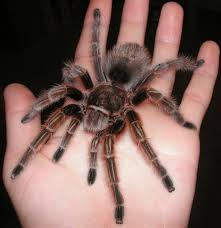 Eight-Legged Pets
Eight-Legged Pets
You may not think of big hairy spiders as pets, but some people do, and Petco wants their business. The company has announced it is expanding their 'tarantula offerings' to give pet parents the chance to further explore the amazing world of arachnids. The retailer says it is also proud to share that with this launch of more than 20 breeds, all of Petco's tarantulas will be captive-bred, adding that, "These unique and fascinating animals are a great addition to any home, offering endless learning opportunities for the whole family." Interestingly, not only do tarantulas have eight legs, they also have a large round eye surrounded by three smaller ones on each side for a total of eight eyes as well. They also shed their exoskeleton, or molt, in order to grow, doubling in size with each molt. And, did you know that female tarantulas can live up to 30 years while males have significantly shorter lifespans of up to seven years with proper care? Some of the breeds they'll carry include: Mexican Curly Hair, Rear Horned Baboon tarantula, Guyana Pink Toe, Mozambique Golden Baboon, Costa Rican Tiger Rump and the Ivory Ornamental Tarantula.
 Don't Walk Your Dog By Hanging Leash Out of Car
Don't Walk Your Dog By Hanging Leash Out of Car
A California woman captured video of another woman driving her car and walking her dog by holding its leash out of the car window. The woman who took the video also confronted the woman in the car asking why she was walking the dog like that and the driver defends herself, saying the dog wasn't being dragged. But then the video shows the car speed up, forcing the dog to run along beside the car to avoid being dragged. The director of the local animal services department in Stockton also said he found the video distressing and recommended the woman be charged with animal cruelty, but police reviewed the video and did not believe there was evidence of cruelty, but said the woman in the car would have been charged with 'distracted driving' IF she had been seen by an officer.
The World of Pets Is Changing
Off-leash dog parks leads the pack in the type of new urban parks being built, growing by 4-percent just last year and 89-percent since 2007, according to The Trust for Public Land's most recent data on the nation's 100 biggest city park systems across the country. Nearly every big city now has at least one dedicated dog park, often with a name that reflects the creativity of the movement. Fort Worth pups play at Fort Woof; Memphis pets frolic at Overton Bark; Dallas dogs run at My Best Friend's Park; and Atlanta pooches have their own Freedom Barkway. The 2016 City Parks Facts report compiles data about parks in the nation's largest 100 cities. When it comes to the number of dog parks, the cities that score the highest on a per-resident basis are Henderson, Nevada; Portland, Oregon; Norfolk, Virginia; Las Vegas, Nevada; and Madison Wisconsin.
 Domestic Dispute Turns Out To Be Parrot
Domestic Dispute Turns Out To Be Parrot
Police in Brighton, Canada were called out to a home recently on what was a routine Tuesday night that turned out to be very unusual. It was 8 o'clock at night and neighbors heard what they believed to be a domestic dispute, since they knew a couple lived there. But when police arrived, they could find only one person inside. Police said neighbors told them they heard the man yelling and saying, 'I hope you die,' and other horrible things. It turns out that the man was home alone and had been screaming at his pet parrot that apparently was 'beaking off,' in his words. You might have guessed, the man had been drinking, but the parrot did not appear to be hurt. No charges were filed.
Social Media Creates Popular Pets
Mars Petcare US, the world's largest pet care company, announced the results of a survey exploring how pets have invaded pop culture, even becoming megastars in their own right, all thanks to the power of social media. They found that we are pretty pet obsessed. About 65-percent of pet owners post about their pets an average of two times per week. More than half of pet owners polled care more about getting 'likes' and/or comments for their pet-related posts than they do for those most other topics. And, 30-percent of us who have pets follow famous animals online. It's obvious; pets have really become a major part of our digital lives.

NEWS UPDATE brought to you by Drs. Foster & Smith, affordable pet supplies. Low prices every day, so you save on every order.
 Listen to the entire Podcast of this show (#858)
Listen to the entire Podcast of this show (#858)



 Daniel Williams quit his regular job to open a pet transport business, like Zoo-ber. He says it's going well although he has one customer than demands he talks to their dog only in 'baby-talk.'
Daniel Williams quit his regular job to open a pet transport business, like Zoo-ber. He says it's going well although he has one customer than demands he talks to their dog only in 'baby-talk.' We're on the heels of another big flea season. Chances are good your pets will get fleas, unless you live in Las Vegas or Phoenix. Is there a safer solution than the traditional topicals? Doc Halligan says there are lots of safe remedies for the 'battle of the fleas.'
We're on the heels of another big flea season. Chances are good your pets will get fleas, unless you live in Las Vegas or Phoenix. Is there a safer solution than the traditional topicals? Doc Halligan says there are lots of safe remedies for the 'battle of the fleas.' Learning more about fleas and their life cycle will help you understand why they become so prolific in such a short period of time and how to avoid an infestation. Although fleas thrive at 65 to 80 degrees F with humidity levels at approximately 80-percent, they have been known to survive indoors during the winter, even in cold climates. Fleas also travel - as much as one mile in an hour. They will hop inside through an open door or window and are often small enough to come through a window screen. Once inside your home, there's no place a flea can't go. Fleas can be miserable for you and your pet, and not just from the bites.
Learning more about fleas and their life cycle will help you understand why they become so prolific in such a short period of time and how to avoid an infestation. Although fleas thrive at 65 to 80 degrees F with humidity levels at approximately 80-percent, they have been known to survive indoors during the winter, even in cold climates. Fleas also travel - as much as one mile in an hour. They will hop inside through an open door or window and are often small enough to come through a window screen. Once inside your home, there's no place a flea can't go. Fleas can be miserable for you and your pet, and not just from the bites.  Flea facts:
Flea facts: Vegas Bats Positive for Rabies - What's the Risk? -
Vegas Bats Positive for Rabies - What's the Risk? - What Kind of Animals Carry Rabies?
What Kind of Animals Carry Rabies?
 If those 5 are the most common, here are 5 that aren't so common, but are still gaining ground as pets in households. I'm not advocating them as pets, and in some states these are illegal to own as pets, so know the laws and your practical capabilities before adopting one.
If those 5 are the most common, here are 5 that aren't so common, but are still gaining ground as pets in households. I'm not advocating them as pets, and in some states these are illegal to own as pets, so know the laws and your practical capabilities before adopting one.
 Next up, and this one doesn't surprise me, are Pygmy goats. Pygmy goats require less work than regular goats and are much more friendly. These aren't the screaming, crying or fainting goats all the rage on the Internet, but these compact and friendly goats are becoming increasingly popular as pets.
Next up, and this one doesn't surprise me, are Pygmy goats. Pygmy goats require less work than regular goats and are much more friendly. These aren't the screaming, crying or fainting goats all the rage on the Internet, but these compact and friendly goats are becoming increasingly popular as pets.
 My final two are sure to cause a stink and make a point. Yes, skunks are kept by some as pets as they can use a litter box and even bond at an early age with humans. Finally, Hedgehogs. Every list should include a hedgehog. Hedgehogs, in the places they are legal, are growing in popularity because of their low maintenance needs and being gentle and bonding pets.
My final two are sure to cause a stink and make a point. Yes, skunks are kept by some as pets as they can use a litter box and even bond at an early age with humans. Finally, Hedgehogs. Every list should include a hedgehog. Hedgehogs, in the places they are legal, are growing in popularity because of their low maintenance needs and being gentle and bonding pets.  The Dogfather's Grooming Tip with
The Dogfather's Grooming Tip with  Joey has done tests with the top three products and unfortunately he doesn't see any difference. He has talked to some of the chemists who are actually making aromatherapy shampoos, and they state that if the product doesn't have the true form of essential oils, meaning 100-percent, it's not going to have the effect that you're looking for. Plus, with most shampoos, you are diluting them, which decreases the amount of oils even more.
Joey has done tests with the top three products and unfortunately he doesn't see any difference. He has talked to some of the chemists who are actually making aromatherapy shampoos, and they state that if the product doesn't have the true form of essential oils, meaning 100-percent, it's not going to have the effect that you're looking for. Plus, with most shampoos, you are diluting them, which decreases the amount of oils even more. Animal Radio News -
Animal Radio News -  Eight-Legged Pets
Eight-Legged Pets
 Don't Walk Your Dog By Hanging Leash Out of Car
Don't Walk Your Dog By Hanging Leash Out of Car
 Domestic Dispute Turns Out To Be Parrot
Domestic Dispute Turns Out To Be Parrot
